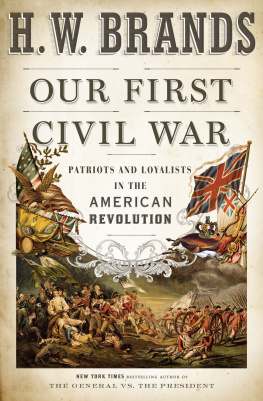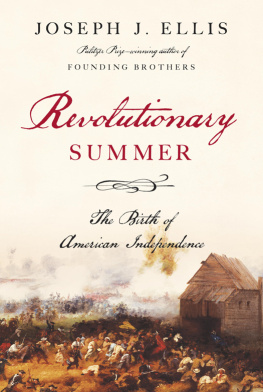ROBERT G. PARKINSON
Acknowledgments
This book is about the consequences of setting thoughts down in type, a process that can have terrible power. Some people in this book used that power to motivate other people through print, at the tragic expense of still others. Those words, set into type, come down to us as artifacts too easily drained of the emotions and intentions that surrounded their original composition. Now this book, too, is an artifact, another collection of types conveying an argument. When I look at this relic, however, I will be pleasantly reminded of all of the emotions and intentions of the good people whose support was essential in the decade it took to make it a tangible object. Years from now, it gives me great pleasure, this object will be a capsule on my shelf containing the memory of all the intangible love that is interwoven into the skeins of wood pulp that comprise each page.
First, there is Peter Onuf. For a decade and a half, ever since he asked me to come along on a very memorable walk in Knoxville, Peter has been a model in just about every way: as a mentor, a scholar, a teacher, and a person. It has been my great, great fortune to be counted among his students. He knew when to push and when to let me be. He listened and offered consistently excellent advice on all topics about the present and the past. I know he wished to have seen this artifact several years ago, but I wanted to get it right, in no small part as a testament to the scholarship he taught and practiced. My gratitude to him is boundless. Thank you so much, Peter.
Other teachers in Charlottesvillethe late Steve Innis, John Stagg, Brian Balogh, and Ed Russellcontinue to shape my views of the American past. At the head of this list is Edward Ayers. Though this book is not about his war, Eds influence is manifest throughout. He is another model for how historians should write, teach, and engage the American public. Thank you, Ed, not only for your moving and infectious engagement with the past, but also your taking a fellow University of Tennessee alum under your wing.
Before Charlottesville, my mentor in Knoxville was the indomitable Bruce Wheeler. This book would not exist if it hadnt been for Bruce and his writing partner, the late Susan Becker, taking a special interest in a nave undergraduate and channeling their excitement for the past into professional avenues. Wheelers particular skill to weave stories about the American past inspired countless students. I, certainly, can attest to being among them. Thank you, Professors Wheeler and Becker.
At various stages this project has received institutional support in the form of research and writing fellowships from the International Center for Jefferson Studies, the David Library of the American Revolution, the Colonial Williamsburg Foundation, the Clements Library at the University of Michigan, and the Library Company of Philadelphia. My thanks go to Andrew OShaughnessy of the ICJS, Meg McSweeney at the DLAR, James Horn, now of the Jamestown Rediscovery Foundation, John Dann of the Clements Library, and James Green at the LCP for their support and assistance.
I owe Jim Green of the Library Company my great thanks for putting me up in the Cassatt House next to Brad Jones in September 2004. He said he thought it would be good if I got to know Brad, then over from Scotland working on similar issues regarding Revolutionary mobilization. He couldnt have been more right. That coincidence turned into one of my most important friendships. Although he scarcely knew it, a few timely phone conversations with Brad repeatedly saved this project from collapse. His hospitality, encouragement, collegiality, and support are present throughout these pages. Thank you, Brad and Flo.
My further thanks to some pretty great friends (and pretty great historians) who have been in my corner over the years: Jan Lewis, Brian Murphy, Johann Neem, James Lewis, Charlene Boyer Lewis, Honor Sachs, Ben Carp, Carrie Janney, Molly Warsh, and Leonard Sadosky.
Jim Horn has been very important to this study in several capacities, but perhaps the most important was his arranging of fellows at the Rockefeller Library to give informal talks to interested folk in Williamsburg. When it came time for mine, Ron Hoffman, Chris Grasso, and Fredrika Teute slipped into the back row of the room. The conversation that afternoon didnt go as I would have liked, so those three very busy pillars of the Omohundro Institute invited me for coffee the next morning to iron out some of my projects wrinkles. That was way over and above, the first of many examples of their generosity and encouragement of young scholars.
From 2007 to 2009 I had the great fortune to continue those conversations as a National Endowment of the Humanities Post-Doctoral fellow at the Omohundro Institute of Early American History and Culture. The NEH and the Institute gave me the gift of time to mull the questions and concepts at the heart of this book. The decision I made early on in Williamsburg to rewrite the entire work was only possible because of this incredible opportunity. Ron, Chris, and, especially, Fredrika have continued to be great believers in this project and its author. Their confidence in me has been a sustaining force over many years, and I am deeply grateful for their investment. Rons guidance and community building, Chriss critical eye and sage advice, and Fredrikas vision and impeccable standards were central in the creation of this book. It is an honor to be a part of the Institute series.










